Google Sheets Line Drawing Not Showingup
How to Make a Line Graph in Google Sheets – Video tutorial:
Nothing conveys and represents data as clearly as a line graph.
From statistics to evolving data, line graphs are a sure way to record and monitor informational changes accurately.
With the use of line graphs, trends clearly appear, allowing individuals and companies alike to adjust their operational procedures to reach their overall goals and objectives.
Let us explore line graphs in more detail, and discover how to make a line graph in Google She
Overview of Line Graphs
Line graphs have straight, solid lines connecting solid, data points called "markers", and display the line segments chronologically.
Line graphs have an "x-axis" (or horizontal axis) and a "y-axis" (or a vertical axis), which differentiate between the categories and the measurement values, respectively.
For example, if a company wants to compare their revenue between 2018 and 2019, a line graph would be the best way to display the information and observe the trends.

But before an effective and efficient line graph is created, it's important to know what the essential parts of a line graph are. By understanding the different parts of a line graph, information can be displayed in the way it is meant to be conveyed.
So, let's examine the different parts of a Google Sheets line graph, and then discover the steps to create one!
Important Parts of a Line Graph
The important parts of a line graph include:
- Y-Axis (vertical axis)
- X-Axis (horizontal axis)
- Chart Title
- Markers
- Grid
- Y-Axis Label
- X-Axis Label
- Legend
Purpose of Line Graphs
But what exactly is a line graph? A line graph is a graph that displays the relationship between two or more changing quantities over time. However, a line graph can also display just one changing quantity if there is nothing to compare it to.
The best time to use a line graph is when you need to demonstrate trends, changes, increases, decreases, etc. A line graph is more intuitive to show changing and evolving trends than other types of graphs.
Line graphs are best used for:
- Showing evolving data
- Showing how two continuous variables relate to one another
So, let's dive right in and start creating a Google Sheets line graph.
How to Make a Line Graph in Google Sheets
Below are the steps to make a line chart in Google Sheets
Step 1: Enter data in Google Sheets.
This is the most important step because what you enter in your Google Sheets spreadsheet is what will be conveyed in your line graph.
Below is the entered data for the example above. Notice how cell A1 is empty.
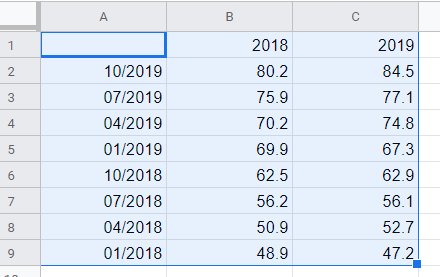
If you are creating a multiline graph, cell A1 will always be empty.
Step 2: Highlight the data, and click on the chart icon.
Select the entire dataset for which you want to insert the line chart and then click on the chart icon in the toolbar.
![]()
You can also do the same by going to the Insert option on the menu and then clicking on the Chart option.
![]()
However, most of the time, Google will determine the entered data is appropriate for a line graph, and will automatically populate one for you so you don't have to select it.
In case it doesn't,
- Click on the chart
- Click on the three dots that appear on the top-right part of the chart,
- Click on Edit chart
This will open the 'Chart editor' pane on the right. You can change the chart type from the 'Chart type' options (and select a line chart if that has not already been inserted)
Once you have the line chart in the worksheet, you can now fine-tune the chart using the Chart Editor.
Step 3: Choosing the Right Chart Type Settings
In the Chart editor, you get access to a number of 'Chart type' setting options.
This first dropdown box under "setup" allows you to select the type of graph you want to use. The three options include:
-
- Regular Line chart
- Smooth line chart
- Combo line chart
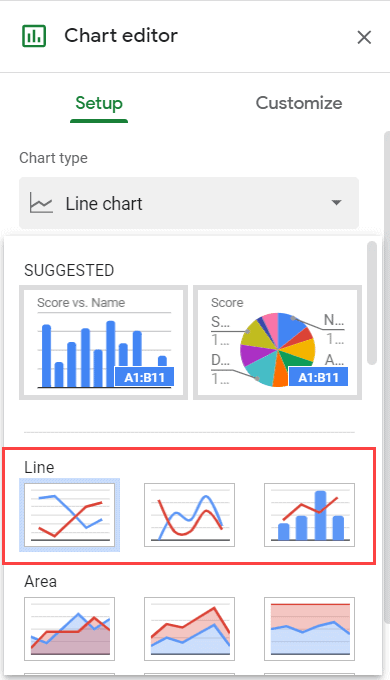
The difference between the three options is shown below.
The image below is of a regular line chart
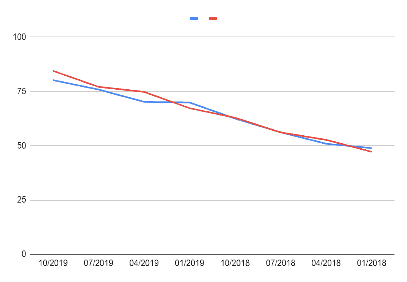
The image below is of a smooth line chart
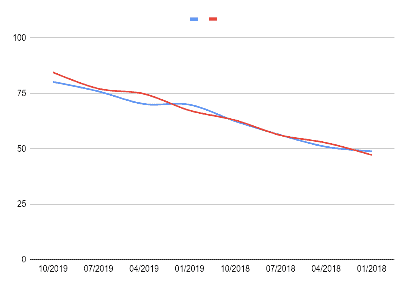
The image below is of a Combo line chart
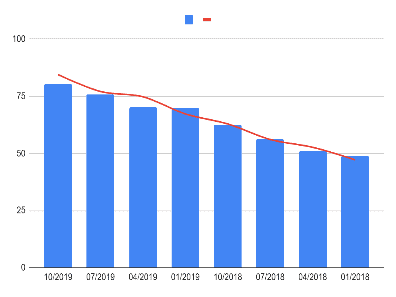
A regular line graph will have a more jagged appearance, while a smooth line graph will have flowing lines. A combo line graph will combine a line graph with a bar graph. While the choice for how you want your graph to appear is yours, the most popular choice is the regular line graph as the data is displayed more directly and precisely.
Note that the combo line chart only makes sense when you have two series of data.
Below are some other options you have in the Chart setup pane:
- Data range: This is the range of cells you highlighted from your spreadsheet to create your chart.
- X-Axis : This is the range of cells from your spreadsheet that make up your chart's X-Axis.
- Aggregate: When the aggregate box is checked, it allows you to aggregate all values that share an identical X-Axis key. For your series or lines, the aggregate dropdown box will give you the option of displaying the data's:
- Average
- Count
- Max
- Median
- Min
- Sum
- Aggregate: When the aggregate box is checked, it allows you to aggregate all values that share an identical X-Axis key. For your series or lines, the aggregate dropdown box will give you the option of displaying the data's:
- Series : Each line represented in your chart is called a "series". The three dots at the end of the series bar give you the option to add labels or remove them.
- Switch Rows/Columns box : When checked, this will change your X-Axis data to the Y-Axis, and vice versa.
- Use Row 1 as Headers: By checking this box, you're using the labels from row one of your spreadsheets and creating a legend for your chart.
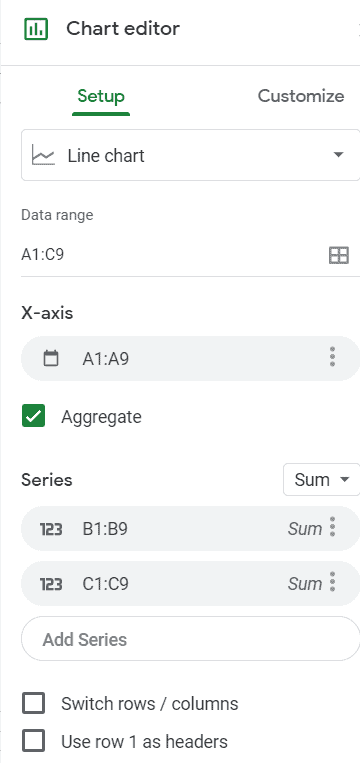
Step 4: Doing some Chart Customization
In the chart editor next to the right of the setup tab is the customization tab. This tab will allow you to customize the:
- Chart style
- Chart and axis titles
- Series
- Legend
- Horizontal Axis
- Vertical Axis
- Gridlines
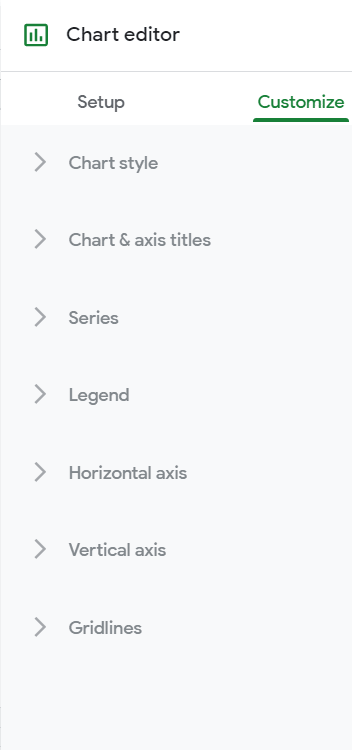
From font style to font size and from alignment to color, the customization tab truly allows you to make your chart your own.
- Chart Style: Under this section, you're given the opportunity to change the background color of your chart, as well as the chart's border color and font. You can decide if you want your chart to have smooth lines, a maximized view, plotted null values, or a compare mode layout.
- Chart & Axis Titles: Every chart needs a title so the audience knows what information they're looking at. The chart and axis title section allows you to not only give your chart and each axis a title, but change the font style, font size, format, alignment, and color as well.
- Series: Here you can customize the style of your lines. By adjusting each line's thickness, the marker point size, and the marker point shape, you can create the chart that most clearly displays the information you want to convey. In this section, the aggregate dropdown menu allows you to select the type of aggregate you want your chart to display. You can even customize a specific marker on your chart under "format data point" 🡪 "add". You can even select to display features such as error bars, data labels, and trendlines.
- Legend: This menu allows you to position your legend in your desired spot, as well as change the legend's font, size, format, and text color.
- Horizontal Axis: Like the customization options above, the horizontal axis menu gives you the opportunity to change the label font, label font size, label format, and text color. Two boxes under this section also allow you to alter your chart by creating labels as text and reversing axis order.
- Vertical Axis: Once again, with a choice of font, font size, format, and color, this menu option has two blank boxes to enter a minimum and maximum values for the Y-Axis. You can check the box "treat labels as text", as well as change the scale factor to include punctuation in your values. If you wish, you can customize the vertical axis by checking the "log scale" box, as well as change the number format by selecting your desired style from the corresponding dropdown menu.
- Gridlines: Gridlines can be helpful when displaying data. They provide a perspective that helps an audience better understand and comprehend the data provided. By selecting the major and minor gridline count, as well as the major and minor gridline colors, charts certainly come to life as does the data they display.
So this is how to make a line ch in Google Sheets. We hope this tutorial has helped you learn exactly how to make a line graph easily in any Google Sheet you may be working on.

Sumit
Spreadsheet Expert at Productivity Spot | Website | + posts
Google Sheets and Microsoft Excel Expert.
-
Sumit
https://productivityspot.com/author/sumitbansal23/
-
Sumit
https://productivityspot.com/author/sumitbansal23/
-
Sumit
https://productivityspot.com/author/sumitbansal23/
-
Sumit
https://productivityspot.com/author/sumitbansal23/
You May Also Like the Following Tutorials:
Google Sheets Line Drawing Not Showingup
Source: https://productivityspot.com/line-chart-google-sheets/
0 Response to "Google Sheets Line Drawing Not Showingup"
Postar um comentário